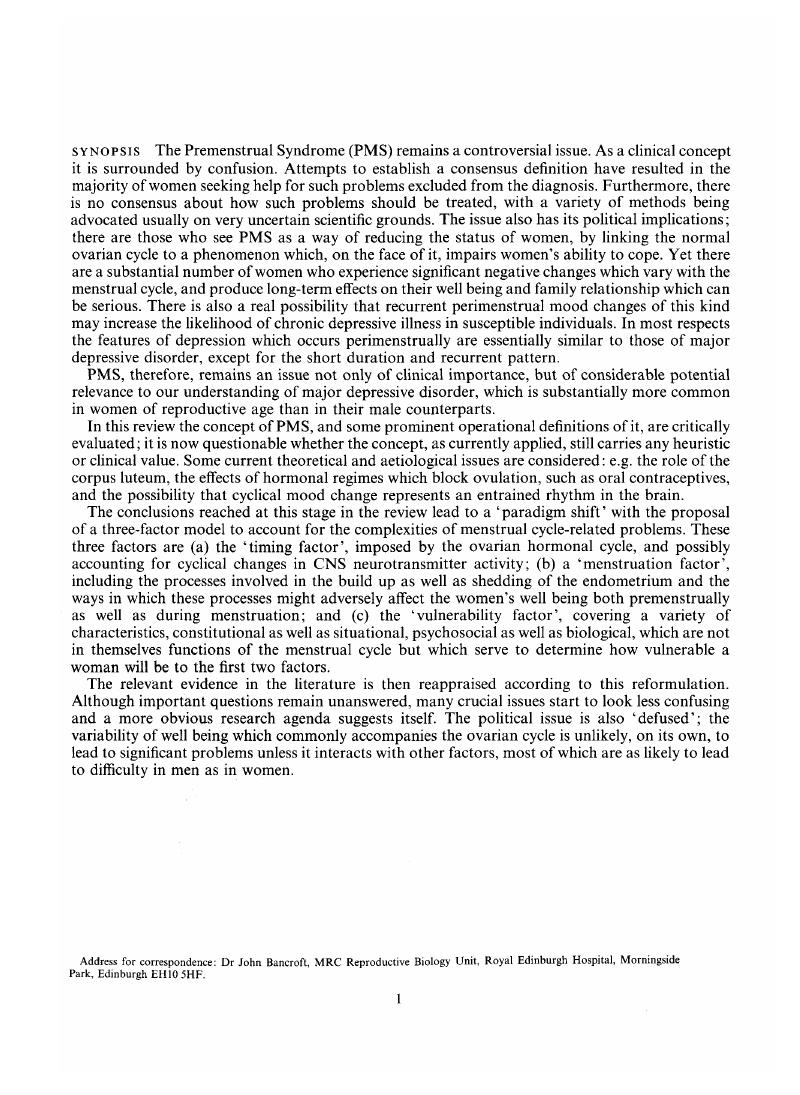Crossref Citations
This article has been cited by the following publications. This list is generated based on data provided by Crossref.
1993.
Migraine and Premenstral Syndrome.
Cephalalgia,
Vol. 13,
Issue. 6,
p.
376.
Menkes, David B.
Coates, Diane C.
and
Fawcett, J.Paul
1994.
Acute tryptophan depletion aggravates premenstrual syndrome.
Journal of Affective Disorders,
Vol. 32,
Issue. 1,
p.
37.
Dye, Louise
Warner, Pamela
and
Bancroft, John
1995.
Food craving during the menstrual cycle and its relationship to stress, happiness of relationship and depression; a preliminary enquiry.
Journal of Affective Disorders,
Vol. 34,
Issue. 3,
p.
157.
Borrelli, Belinda
Bock, Beth
King, Teresa
Pinto, Bernardine
and
Marcus, Bess H.
1996.
The Impact of Depression on Smoking Cessation in Women.
American Journal of Preventive Medicine,
Vol. 12,
Issue. 5,
p.
378.
Smith, Helen
and
Thomas, Sandra I
1996.
Anger and Locus of Control in Young Women with and without Premenstrual Syndrome.
Issues in Mental Health Nursing,
Vol. 17,
Issue. 4,
p.
289.
Roca, Catherine A
Schmidt, Peter J
Bloch, Miki
and
Rubinow, David R
1996.
Implications of Endocrine Studies of Premenstrual Syndrome.
Psychiatric Annals,
Vol. 26,
Issue. 9,
p.
576.
Bloch, Miki
Schmidt, Peter J.
and
Rubinow, David R.
1997.
Premenstrual Syndrome: Evidence for Symptom Stability Across Cycles.
American Journal of Psychiatry,
Vol. 154,
Issue. 12,
p.
1741.
Oxley, Tanith
1998.
The Feminism & Psychology Undergraduate Prize 1997 — Prizewinning Entry Menstrual Management: An Exploratory Study.
Feminism & Psychology,
Vol. 8,
Issue. 2,
p.
185.
Hunter, Myra
and
Walker, Anne
1998.
Comprehensive Clinical Psychology.
p.
361.
Ussher, Jane M.
2001.
Cambridge Handbook of Psychology, Health and Medicine.
p.
830.
Rubinow, David R.
Schmidt, Peter J.
Roca, Catherine A.
and
Daly, Robert C.
2002.
Hormones, Brain and Behavior.
p.
37.
Ussher, Jane M.
2002.
Processes of appraisal and coping in the development and maintenance of Premenstrual Dysphoric Disorder.
Journal of Community & Applied Social Psychology,
Vol. 12,
Issue. 5,
p.
309.
Wieck, A.
Davies, R. A.
Hirst, A. D.
Brown, N.
Papadopoulos, A.
Marks, M. N.
Checkley, S. A.
Kumar, R. C.
and
Campbell, I. C.
2003.
Menstrual Cycle Effects on Hypothalamic Dopamine Receptor Function in Women with a History of Puerperal Bipolar Disorder.
Journal of Psychopharmacology,
Vol. 17,
Issue. 2,
p.
204.
Ussher, Jane M.
2003.
The ongoing silencing of women in families: an analysis and rethinking of premenstrual syndrome and therapy.
Journal of Family Therapy,
Vol. 25,
Issue. 4,
p.
388.
Van-Leeson, Terri
Totterdell, Peter
and
Parkinson, Brian
2006.
Moderating effects of mood monitoring on premenstrual dysphoria.
Cognition & Emotion,
Vol. 20,
Issue. 8,
p.
1236.
Greco, Teri
Graham, Cynthia A.
Bancroft, John
Tanner, Amanda
and
Doll, Helen A.
2007.
The effects of oral contraceptives on androgen levels and their relevance to premenstrual mood and sexual interest: a comparison of two triphasic formulations containing norgestimate and either 35 or 25 μg of ethinyl estradiol.
Contraception,
Vol. 76,
Issue. 1,
p.
8.
Oyebode, Femi
2008.
Sims' Symptoms in the Mind: An Introduction to Descriptive Psychopathology.
p.
83.
Bancroft, John
2009.
Human Sexuality and Its Problems.
p.
439.
Shuli, Xu
2011.
Clinical study on treatment of premenstrual syndrome by acupuncture and moxibustion.
Journal of Acupuncture and Tuina Science,
Vol. 9,
Issue. 5,
p.
310.
Ussher, Jane M.
and
Perz, Janette
2013.
PMS as a process of negotiation: Women’s experience and management of premenstrual distress.
Psychology & Health,
Vol. 28,
Issue. 8,
p.
909.



